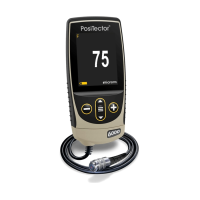Page 11
should be taken to obtain an average.
Repeatedly measure the uncoated steel part. The Gage will wait two seconds after
placing the probe on the surface to allow the user to correctly position the probe. After
the last measurement, the Gage will calculate a Zero which represents the average of
all the F Zero readings taken.
2pt Adjustment
Provides greater accuracy within a limited, defined range, and is the preferred method
for very unusual substrate materials, shapes or conditions.
Press (+) to select the number of readings to be used to obtain an average, typically 3
to 10 readings. The greater the variation between readings, the more readings should
be taken to obtain an average.
Repeatedly measure the first known thickness reference. The Gage will wait 2 seconds
between readings to allow the user to correctly position the probe on the surface. After
the last measurement the Gage will calculate and display a thickness value which
represents the average of all the readings taken using the factory calibration settings.
Lift the probe from the surface and adjust the displayed reading down (-) or up (+) to the
known thickness value of the first thickness reference. Press the center button to accept
this value.
Repeat these steps for the second thickness reference.
Cal Lock
When enabled (default), the Calibration Lock icon will appear on the display. This
prevents an adjustment from being performed inadvertently if the (-) or (+) buttons are
pressed.
Zn Zero
(PosiTector 6000 FNDS only)
Measure the unpainted zinc surface (if available). If the average of several N readings is
not within tolerance of 0, perform an Zn Zero adjustment.
Press (+) to select the number of readings to be used to obtain an average, typically 3
to 10 readings. The greater the variation between readings, the more readings should
be taken to obtain an average.

